Skin Disorders in Older Adults: Dermatoses Related to Scratching, Rubbing, and Impaired Epidermal Integrity, Part 1
Physical changes that occur in aging skin (eg, dryness and thinning) can result in pruritus and cause patients to rub, scratch, and pick at their skin. These activities produce various dermatoses and reactive changes in the skin, such as postinflammatory pigmentary alteration. Lichen simplex chronicus (LSC) develops as a physiological cutaneous response to repetitive scratching or rubbing. First-line treatment consists of topical corticosteroids and application of ice to reduce the sensation of itching. Like LSC, prurigo nodularis results from rubbing and scratching the skin. Treatment is similar; however, intralesional corticosteroids and UV therapy play more of a role because prurigo nodularis is more intensely pruritic than LSC.
The skin of elderly persons is thinner and drier and possesses a greater number of growths than the skin of young and middle-aged persons. These physical changes are accompanied by other changes in lifestyle and psychological state that appear to make elderly persons more prone to rub, scratch, and pick at their skin.
Such activities result in a variety of dermatoses and evoke various reactive changes in the skin that will be reviewed in this 2-part series. Here I discuss postinflammatory pigmentary alteration (PIPA), amyloidosis, lichen simplex chronicus (LSC), and prurigo nodularis. In a coming issue (August 2010), I will address neurotic excoriations, perforating disease, chondrodermatitis nodularis chronica helicis, hyperkeratosis of the foot, calluses and corns, and intertrigo.
PIGMENTARY ALTERATION CAUSED BY SCRATCHING
PIPA is caused by 3 interrelated mechanisms that operate in whole or in part:
•Epidermal melanosis.
•Dermal melanosis.
•Pigmentary incompetence.
Among the most common causes of PIPA in elderly persons are rubbing and scratching of the skin
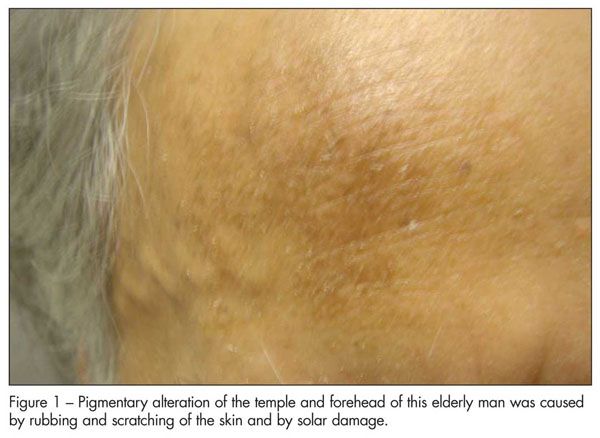
(Figure 1) and solar damage.
The epidermal inflammatory response (ie, dermatitis) results in the release of inflammatory mediators that alter the activity of both immune cells and melanocytes, which increase pigment production and the transfer to and fixation of melanin in keratinocytes, all of which manifest as epidermal hypermelanosis. Dermal melanosis occurs when inflammation disrupts the basal cell layer, releasing melanin pigment, which is subsequently trapped by papillary dermal macrophages; this effect is also known as pigmentary incontinence. Dermal melanosis can be related to the localization of melanocytes in the dermis, which appears blue because of the Tyndall effect (the preferential absorption of long light wavelengths by melanin and the scattering of shorter wavelengths, representing the blue end of the spectrum, by collagen bundles).1
If the cause of PIPA is unclear, a biopsy is helpful in excluding other underlying causes of hyperpigmentation. Staining of the biopsy specimen with Fontana-Masson silver stain for melanin enables localization of the melanin in the epidermis and/or the dermis. The color of the lesions ranges from light brown to black, with a lighter brown appearance if the pigment is within the epidermis (ie, epidermal melanosis) and a darker gray appearance if lesions contain dermal melanin (ie, dermal melanosis).
Treatment of PIPA is difficult. When it appears on the face, combination therapies of a retinoid, hydroquinone, and a mild corticosteroid can be helpful.2 The best therapy for PIPA on the body is the tincture of time because the pigmentary alteration tends to lessen over time and responds poorly to treatment.
MACULAR AND LICHEN AMYLOIDOSIS
Amyloidosis results from the production and extracellular deposition of an abnormal fibrous protein that has specific characteristics. Several amyloid proteins are associated with pathological systemic and cutaneous processes. Macular and lichen amyloidosis result from the deposition of amyloids that originate in keratin breakdown products.
Macular amyloidosis starts as flat dusky-brown or grayish macules that may coalesce to form reticulated or rippled brown patches. It manifests symmetrically over the upper back between the shoulder blades, on the chest, and sometimes on the arms and legs (Figure 2). Macular amyloidosis
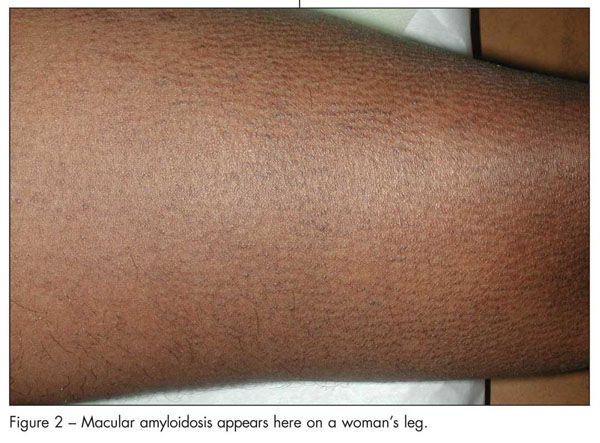
is usually pruritic. It occurs earlier in life than lichen amyloidosis, typically in persons who are in their 20s or 30s. Macular amyloidosis is said to be more common in Hispanic persons and in women.3
The mainstay of treatment is corticosteroids and other topical preparations that decrease pruritus.
Lichen amyloidosis presents as an intensely itchy eruption of red-brown papules on the shins, thighs, feet, and forearms (Figure 3). The papules can have a reticulated or rippled appearance. Isolated papules can occur as well. Lichen amyloidosis most often first appears in men

and women 50 to 60 years of age. It is said to be more common in persons of Chinese descent and in men.3
Corticosteroids and other topical preparations that reduce pruritus are the mainstay of treatment. Some have suggested that systemic medications such as cyclosporine can be helpful when other treatments fail,4 but I have never used such agents for fear of adverse effects and lack of sustained effect.
LICHEN SIMPLEX CHRONICUSClinical features. LSC is thickening of the skin, with an increase in skin markings, that develops as a physiological cutaneous response to repetitive scratching or rubbing. LSC is a secondary rather than a primary process: that is, pruritus precedes the appearance of LSC.
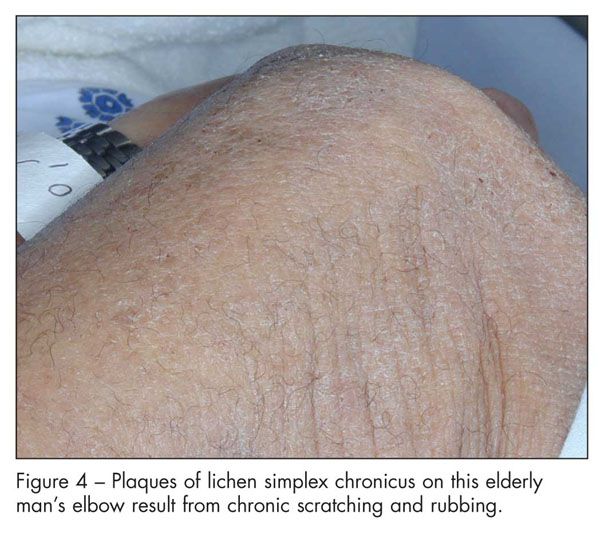
Patients usually report that pruritus is worse in the night when they are about to go to sleep and when they are still or quiet. During the daytime, when patients are occupied with other affairs, the urge to scratch is minimal or nonexistent.
LSC can occur on any body area that the patient can reach to scratch, particularly the scalp, nape of neck, extensor surface of forearms and elbows (Figure 4), vulva and scrotum, outer aspect of the upper medial thighs, knees, lower legs, ankles and, rarely, the hands (Figure 5). It can be associated with erosion and xerosis (Figure 6). There can be overlap between LSC, xerosis, and amyloidosis (Figure 7). LSC that occurs on and around the genitals of men can be marked by striking erythema (Figure 8).
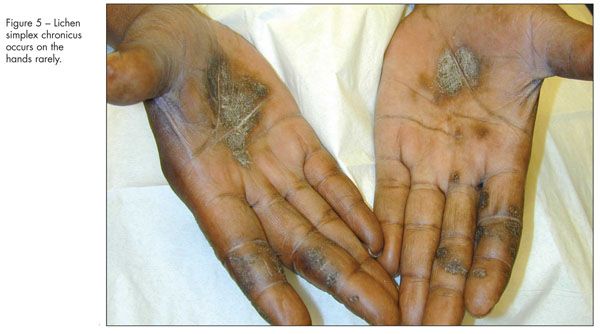
Plaques of LSC average 3 to 6 cm in diameter. These plaques often have 3

zones. A 2- to 3-cm–wide peripheral zone that is minimally hyperkeratotic may have isolated prurigo nodularis papules. The middle zone has lenticular and hemispheric prurigo papules that may be eroded. The central zone of LSC exhibits the most pronounced hyperkeratosis and pigmentary alteration, especially hyperpigmentation.
Treatment. As a first-line treatment, I advise patients to stop scratching and offer advi
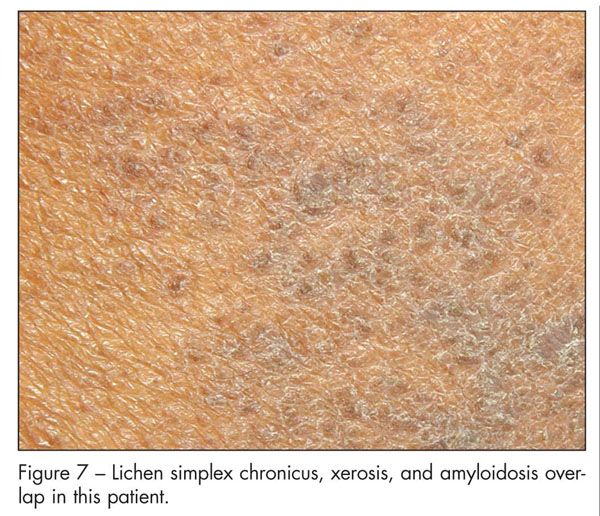
ce on how to decrease the sensation of itching. To try to break the itch-scratch cycle, I initially prescribe a topical corticosteroid of the most potent type; if it is effective, I taper to a less potent corticosteroid. I also tell patients that ice is one of the most effective antipruritic agents and that application of crushed ice in a plastic bag to an area of LSC for 5 to 10 minutes often can reduce the urge to scratch.
As adjuvants to ice and corticosteroids, I prescribe topical doxepin, topical tacrolimus or pimecrolimus, and lidocaine. Menthol, phenol, pramoxine, capsaicin cream, and vitamin D3 ointment can also be used to reduce pruritus. Occlusion of the medication, in particular by the use of corticosteroid-impregnated tape (eg, flurandrenolide [Cordran] tape), can increase the potency and e
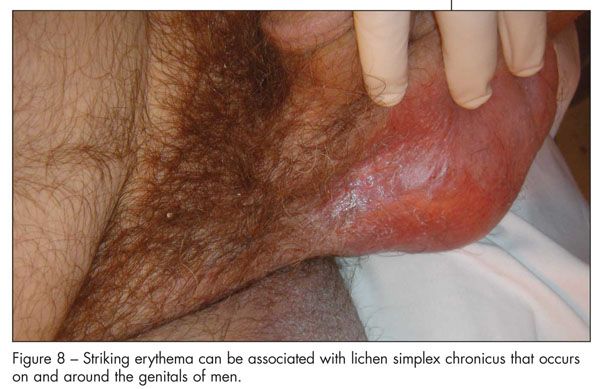
nhance delivery of the antipruritic therapy and provide a physical barrier to scratching.
If plaques occur on the body and do not respond to topical treatments, I inject triamcinolone, 3 mg/mL, into the lesions. LSC may become secondarily infected if erosions develop after it is scratched; in this case, it should be treated with topical mupirocin. Cases of LSC unresponsive to other therapies can be treated with UV-B phototherapy.5 I do not find that oral antihistamines are effective for LSC. No therapy
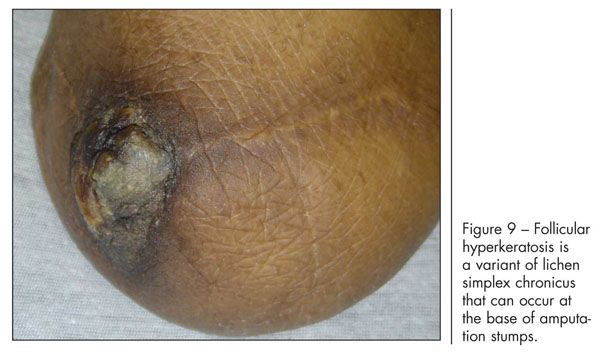
has a 100% success rate, but treatment often decreases the urge to scratch.
Variants of LSC can exist in amputees. These variants include follicular hyperkeratosis (which can be peeled away with a fingernail) (Figure 9) at the bottom of amputation stumps attached to ill-fitting prostheses and wart-like lesions (verrucous hyperplasia) (Figure 10), which are firm and cannot be peeled away. Treatment involves better-fitting shoes and prostheses.
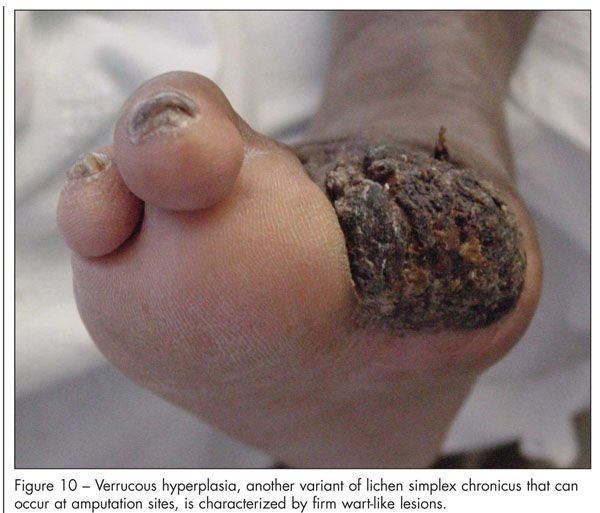
PRURIGO NODULARISClinical features. Prurigo nodularis manifests as hard, hyperpigmented nodules, 1 to 3 cm in diameter, with rough, flat, umbilicated, or crusted surfaces. The papules of prurigo nodularis are larger and firmer than the papules and pustules of folliculitis (Figure 11). Crust and scale may cover recently scratched prurigo nodularis. The skin between the nodules is often dry. Early prurigo nodularis is red and may have some hive-like features.
Like LSC, prurigo nodularis is an eruption secondary to rubbing and scratching the skin. Why LSC develops in one patient and prurigo nodularis in another is uncertain. Prurigo nodularis typically occurs in middle-aged and elderly men and women.
The nodules appear in a scattered array that can range in number from the single d
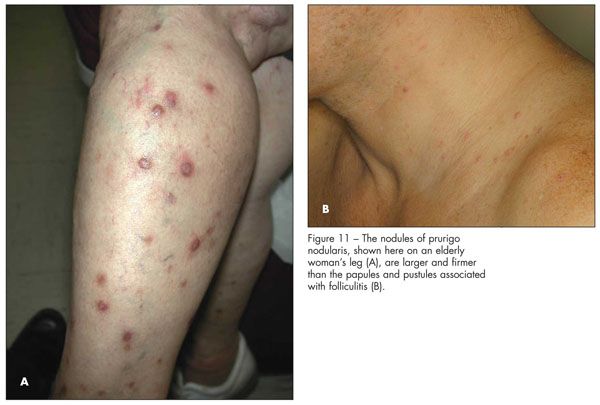
igits to the hundreds. The condition is usually bilaterally symmetrical. Prurigo nodularis initially appears on the lower arms and legs and is more pronounced on the outer aspects of the extremities. Sometimes, the trunk, face, and even palms can be affected. Mature nodules maintain a stable size and rarely spontaneously resolve.
Prurigo nodularis can occur in a variety of conditions associated with pruritus. These include hepatic disease, end-stage renal disease, diabetes, insect bites, HIV infection/immunodeficiency, and anxiety and other psychiatric pathological conditions.
Treatment. The treatment of prurigo nodularis is similar to that of LSC; topical corticosteroids are the mainstay of therapy. Intralesional corticosteroids and UV therapy play more of a role because the pruritus of prurigo nodularis is more debilitating than that of LSC. Cryotherapy is sometimes used on nodules,6 but I have not found it helpful. I avoid oral corticosteroid therapy because this is a short-term measure that has serious risks if used for an extended period.
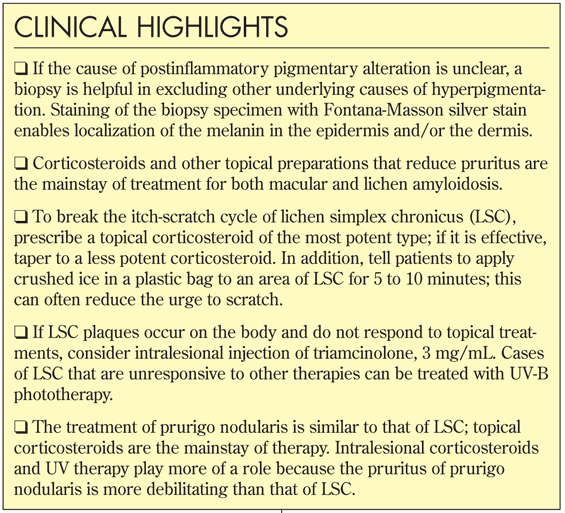
References:
REFERENCES:1. Scheinfeld NS. Skin disorders in elderly persons: part 2, benign growths and neoplasms. Consultant. 2006;46:1589-1602.
2. Pérez-Bernal A, Muñoz-Perez MA, Camacho F. Management of facial hyperpigmentation. Am J Clin Dermatol. 2000;1:261-268.
3. Levine N, Burk C. Cutaneous amyloidosis. In: Nordlund JJ, Boissy RE, Hearing VJ, et al, eds. The Pigmentary System. 2nd ed. Boston: Blackwell; 2006:924-928.
4. Behr FD, Levine N, Bangert J. Lichen amyloidosis associated with atopic dermatitis: clinical resolution with cyclosporine. Arch Dermatol. 2001;137:553-555.
5. Ferrándiz C, Carrascosa JM, Just M, et al. Sequential combined therapy with thalidomide and narrow-band (TL01) UVB in the treatment of prurigo nodularis. Dermatology. 1997;195:359-361.
6. Waldinger TP, Wong RC, Taylor WB, Voorhees JJ. Cryotherapy improves prurigo nodularis. Arch Dermatol. 1984;120:1598-1600.
2 Commerce Drive
Cranbury, NJ 08512
All rights reserved.